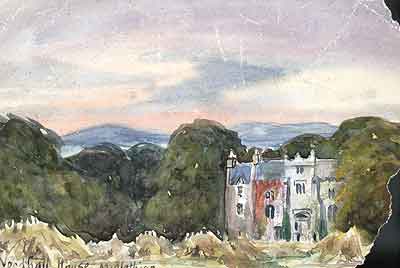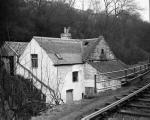Early census returns in JUNIPER GREEN 1841 - 1861
The earliest recorded date found for the words JUNIPER GREEN is in 1707. But, even from those early days there was a reasonably sized settlement in this area in order to support both farming and the numerous Mills, some of which had been in existence since at least the 15th century. Curriemuirend, Woodhall, Kilbaberton (Baberton), Fernieflat & Woodhall Estate are all marked on Laurie's map of 1766.
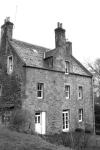
© Royal Commission on the Ancient and Historical Monuments of Scotland. Licensor www.scran.ac.uk
A typical farm at Spylaw
Inevitably, most of the records that can be found before the first census in 1841 are those of the two big Estates of Baberton & Woodhall, but working through various books brought out some interesting facts suggesting that there was quite a centre of population in this area. There were several Mills in the 16th & 17th centuries. Upper Spylaw mill started as a Paper Mill in 1681 changing to Snuff around 1780. Mossy Mill was started by the brothers Mossie and was a Waulkmill going back to the 16th century.
More recently, Curriemuir or Denholm Mill was founded in the early 1700's during the lifetime of Sir John foulis of Woodhall House. This latter mill was on the site which became Woodhall Grain Mill in modern times. The only other recorded early names that could be found were Wright's Grain Mill and Watt's Snuff Mill. All of these Mills plus the numerous Farms needed a number of homes to support them.
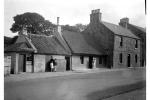
© Royal Commission on the Ancient and Historical Monuments of Scotland. Licensor www.scran.ac.uk
A thatched cottage in Juniper Green
During the years 1841 to 1861 there was a considerable growth in the village with the number of homes increasing from 100 to 172 in only 20 years and the population growing from 418 individuals to 700. This was due in no small part to the expansion of the Paper Mills which saw the residents employed rise from 21 in 1841 to 90 by 1861. In 1845 the population of Colinton was only 119, which may have been due to the few large houses being constructed there rather than the many smaller ones built for the workers in Juniper Green.
In the earlier two census returns of 1841 and 1851, it is not possible to identify where most houses were located as no streets or house names are mentioned. However, the farms of Caledonia, Fernieflat, Bloomiehall and Viewfield are all recorded. It is interesting to note that from the earliest maps Curriemuirend is always named specifically. By the 1861 census Baberton Road (later Baberton Avenue), Belmont Avenue & Wrights Square (though this is only one house) are cited as are many of the named houses such as St Anne's, Mount Pleasant, Viewforth, Ashfield, Annandale, Rosebank, Rosevilla, Hillmount, Woodhall, Spyfield & Maryville. The shops included a Watchmaker, Grocer, Baker, General Merchants, Shoemaker and, of course, a Public House. At that time the public house at Curriemuirend was known as The Old Ship. It had as its proprietor during these 20 years, Mrs Janet Wallace, whose husband William was a Stonemason. William died in the 1840s so is missing from the census returns after 1841! There was also a Grocery shop near that Public house. Another public house in the village is known to have been built around 1830 but it dows not appear by name in the three census returns studied by the author. However, a second public house, presumably the Kinleith Arms, is recorded with its manager Ann Downie in the 1861 census.
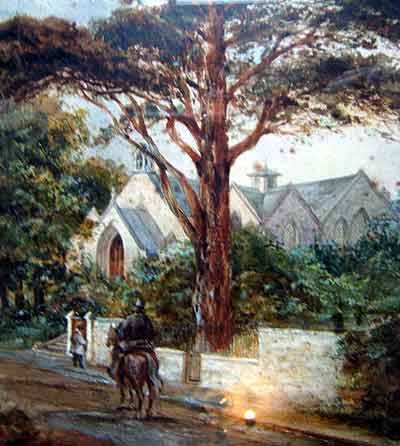
A painting of the original church in Juniper Green by a local landscape artist Frederick Sohns.
There are no churches in the 1841 census, any worshipers had to travel either to Colinton or Currie. Even immediately after the "disruption" in 1843 the Free Church members had to go to either the Society Hall in Currie or Colinton Ballroom for their services. It was not until 1845 that the Free Church opened at its present site on Lanark Road with Harry Anderson as its first minister. The Church of Scotland worshippers had a longer wait as it was not until 1890 before they had their "Iron Church" just west of the present Woodhall Drive.
The census returns also reveal fascinating insights into the lives of the people. The largest families in the village included the Thomas & Jane O'Reilly family with 9 children and John & Mary Henderson with 12 children ranging from 3 weeks to 23 years old in a house with 3 rooms. Leonard & Julia Dea had 10 children spanning from 1 to 20 years of age, but the Dea's did have 4 rooms. Incidentally, there must have been quite a few families with the name Dea in the village, one of which had at least 3 generations of Slaters in it. There was also a nurse Mary Davidson in Belmont Avenue who lived in a 2 roomed house with her daughter, son, grandson & 5 boarders. Susannah Benson & Joan Cleland boarded and taught English to 6 girls aged between 7 & 14 years. Some of the farmers were obviously quite well off, for instance in 1841 Angus Cameron the farmer at Curriemuirend had 2 servants, 6 labourers and a gardener all living on the farm. It is also interesting to note how people with similar occupations lived in close proximity. For instance, the village boasted 3 Surgeons, anything between 6 to 8 Officers of Excise and 5 Shoemakers, all in the little community of Juniper Green.
During these 20 years the most common surnames in the village were Anderson, Dea, Dickson, Downie, Henderson, Hunter, Leechman & Robertson.
References:
- Census returns for 1841, 1851, 1861
- Trade Directories for Edinburgh County
- Villages of Edinburgh Volume 2, M Cant

